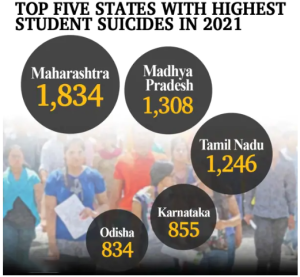Increasing Student Suicides in Higher Education Institutions
Why in News?
The National Crime Records Bureau’s (NCRB’s) Accidental Deaths and Suicide in India (ADSI) report 2021 shows student suicides had gone up drastically during the Covid-19 pandemic in 2020 and 2021 and have been steadily rising in the last five years.
What is the Current Status of Suicides in Students?

Over 13,000 students died by in 2021 in India at the rate of more than 35 every day, a rise of 4.5% from the 12,526 deaths in 2020 with 864 out of 10,732 suicides being due to “failure in examination” according to the latest data as per NCRB’s ADSI report 2021.
- Since 1995, the country lost the highest number of students to suicides in 2021, while nearly 2 lakh of them have died by suicide in the past 25 years.
- The death by suicide of students has increased by 32.15% since 2017, when 9,905 students died by suicide.
- Maharashtra had the highest number of student suicides in 2021with 1,834, followed by Madhya Pradesh and Tamil Nadu.
- The report also showed the percentage of women student suicide was at a five-year low of 43.49%, while men student suicides made up 56.51% of the total student suicides.
- In 2017, 4,711 women students died by suicide, while in 2021 such deaths increased to 5,693.
As per Ministry of Education, 122 students from IITs, NITs, central universities and other central institutions died by suicide over 2014-21. 68 of 122 belonged to the scheduled castes (SC), scheduled tribes (ST) or other backward classes (OBC).
What are the Factors that Increase Suicide Risk?
- Academic Pressure: High expectations from parents, teachers and society can lead to excessive stress and pressure to perform well in exams. This pressure to succeed can be overwhelming for some students, leading to feelings of failure and hopelessness.
- Mental Health Issues: Mental health problems such as depression, anxiety, and bipolar disorder can contribute to student suicides. These conditions can be exacerbated by stress, loneliness, and lack of support.
- Isolation and Loneliness: Many students in educational hubs come from far away and live away from their families and friends. This can lead to feelings of isolation and loneliness, which can be particularly difficult to deal with in an unfamiliar and competitive environment.
- Financial Concerns: Financial difficulties, such as not being able to afford tuition fees or living expenses, can create a great deal of stress and worry for students. This can lead to feelings of hopelessness and desperation.
- Cyber Bullying: Cyber bullying and online harassment are becoming increasingly common and can contribute to student suicides.
- Substance Abuse: Substance abuse and alcohol abuse can contribute to student suicides. Substance abuse can lead to mental health problems, financial difficulties, and legal issues, all of which can be overwhelming for students.
- Relationship Problems: Relationship problems, such as break-ups, family conflicts, and friendship issues can also contribute to student suicides.
- Lack of Support: Many students in educational hubs are reluctant to reach out for help when they are struggling.
What can be Done to Prevent Suicides?
- Improved Mental Health Services: Providing students with access to mental health services and resources such as counselling services, support groups, and psychiatric services can help prevent suicides.
- Embracing Positive Attitude towards Mental Health: Positive attitudes towards mental health and help-seeking must also be promoted through open discussions about mental health and suicide.
- Focus on Overall Personality Development: By taking a holistic approach to personality development, educational institutions can create a supportive and inclusive environment that helps students thrive both academically and emotionally, and can play a critical role in preventing suicides.
- Encouraging Participation in Sports: Sports can play a role in preventing suicides in educational hubs by providing a positive outlet for stress and emotions, as well as increase self-esteem and confidence.
- Addressing the Socio-economic Issues: Socio-economic factors such as poverty, homelessness, and unemployment should be addressed to improve students’ overall well-being and reduce stress, anxiety, and depression.
- Stricter Cyber Bullying Policies: Implementing stricter cyber bullying policies and cracking down on online harassment can help reduce the risk of student suicides.
- Substance Abuse Prevention Programs: Implementing substance abuse prevention programs can help reduce the risk of student suicides.
- Building Positive Relationships: Encouraging students to build positive relationships and connections, offering relationship counselling services, and encouraging students to reach out for help can help reduce the risk of suicide.
- Family Support: Providing students with support from their families can help reduce the risk of suicide.
What are Related Initiatives to Reduce Suicides?
Global Initiatives:
- World Suicide Prevention Day (WSPD):Observed on 10th of September every year.
- World Mental Health Day:10th October is celebrated as World Mental Health Day, every year. The overall objective of World Mental Health Day is to raise awareness of mental health issues around the world and to mobilize efforts in support of mental health.
Indian Initiatives:
- Mental Healthcare Act (MHA), 2017: MHA 2017 aims to provide mental healthcare services for persons with mental illness.
- KIRAN: The Ministry of Social Justice and Empowerment has launched a 24/7 toll-free helpline “KIRAN” to provide support to people facing anxiety, stress, depression, suicidal thoughts and other mental health concerns.
- Manodarpan Initiative: Manodarpanis an initiative of the Ministry of Education under Atmanirbhar Bharat Abhiyan. It is aimed to provide psychosocial support to students, family members and teachers for their mental health and well-being during the times of Covid-19.
- National Suicide Prevention Strategy: Announced in 2023, National Suicide Prevention Strategy is the first of its kind in the country, with time-bound action plans and multi-sectoral collaborations to achieve reduction in suicide mortality by 10% by 2030. The strategy is in line with the World Health Organisation’s South East-Asia Region Strategy for suicide prevention.
